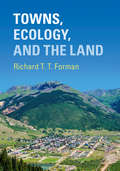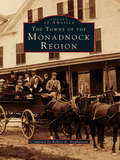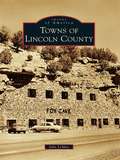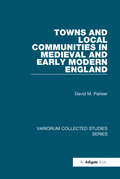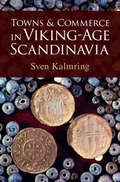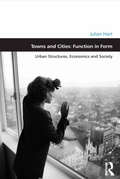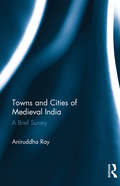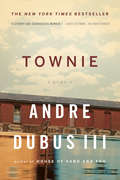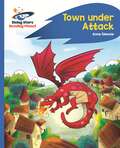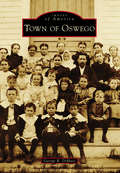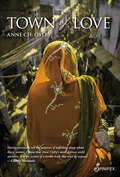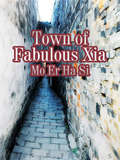- Table View
- List View
Townsend (Images of America)
by Missy Tipton Green Paulette LedbetterSituated in Tuckaleechee Cove, one of several "limestone windows" on the northern base of the Smoky Mountains, is Townsend, Tennessee, also known as the "Peaceful Side of the Smokies." Native Americans were the first inhabitants of Tuckaleechee Cove. By the time the first Europeans arrived in the late 18th century, the Cherokee villages had been abandoned. In the 1880s, the lumber industry was in full swing thanks to two key innovations: the band saw and the logging railroad. With the coming of industrialization, the isolated farming community of Tuckaleechee Cove was transformed in the bustling mill town of Townsend. In 1894, E.J. Kinzel started a mountain retreat in Tuckaleechee Cove, which in later years turned into a mountain hotel with two healing mineral springs.
Towns, Ecology, and the Land
by Richard T. FormanTowns and villages are sometimes viewed as minor, even quaint, spots, whereas this book boldly reconceptualizes these places as important dynamic environmental 'hotspots'. Multitudes of towns and villages with nearly half the world's population characterize perhaps half the global land surface. The book's pages feature ecological patterns, processes, and change, as well as human dimensions, both within towns and in strong connections and effects on surrounding agricultural land, forest land, and arid land. Towns, small to large, and villages are examined with spatial and cultural lenses. Ecological dimensions - water, soil and air systems, together with habitats, plants, wildlife and biodiversity - are highlighted. A concluding section presents concepts for making better towns and better land. From a pioneer in both landscape ecology and urban ecology, this highly international town ecology book opens an important frontier for researchers, students, professors, and professionals including environmental, town, and conservation planners.
Towns of the Monadnock Region, The
by Robert B. StephensonSince the development of photography in the mid-nineteenth century, the camera has been used as atool of both discovery and preservation. Photographs bring alive our image of the past, and can open a floodgate of memories and nostalgia or inspire curiosity and a sense of history. One of the prominent geological features in the southwest corner of New Hampshire is Grand Monadnock, a bald granite mountain that is a constant presence for miles around. Mount Monadnock gives its name to the beautiful region surrounding its base, a region made up of small towns and villages hundreds of years old, places such as Marlborough and New Ipswich,Peterborough and Rindge, Jaffrey and Hancock, Troy and Fitzwilliam, Harrisville and Dublin. The selection of photographs which make up this charming visual history highlights some of the themes important in the rich history of these communities.Around the landmarks of a village--the meetinghouse and common, the inn and the store--we see work and play, celebration and catastrophe; indeed all the elements of daily life as it was played out over a century of change.
Towns of Lincoln County
by John LemayLincoln County is often associated with such legendary figures as outlaw Billy the Kid, Smokey the Bear, and renowned painter Peter Hurd. Named after Pres. Abraham Lincoln in 1869, the new county saw itself through many struggles, including the Lincoln County War, during which cattle barons and landowners bitterly fought over government beef contracts and farmland. At that time, Lincoln was the largest county in the United States and is now home to modern mountain towns such as Carrizozo, Capitan, Ruidoso, and the locally famous ghost town White Oaks, which had been a gold rush boomtown. Lincoln County also contains the beautiful Hondo Valley settlements and ranching communities such as Tinnie, Picacho, San Patricio, Hondo, and Glencoe. From the rolling hills of the Hondo Valley, to the bloody streets of Lincoln, all the way to the forested mountains of Capitan, this retrospective explores the area's rich history.
Towns in a Rural World (Economic Geography Series)
by Teresa de Vaz Eveline van LeeuwenFocusing on the strategic position of towns in rural development, this book explores how they act as hotspots for knowledge creation, diffusion for vital business life and innovation, and social networks and community bonds. By doing so, towns - even the smallest - can cope with processes of socio-economic decline and promote a geographically balanced income distribution and sustainable production structure. The contributors to this volume examine how to take advantage of the great potential offered by urban areas in the rural world to favour competitiveness and encourage economic activity. Taking a European perspective, the authors identify the main socio-economic advantages generated by urbanized population settlements that small and medium-sized rural towns can provide. Although much attention is currently focused on the efficient use of scarce natural resources and land, they argue that towns have an increasingly important economic and social role to play in rural areas.
Towns in Decline, AD100–1600
by T. R. SlaterMany European towns have experienced loss of population, degradation of physical structure and profound economic change at least once since the height of the Roman Empire. This volume is an examination of the various causes of these changes, the results which flowed from them and the reasons why some urban centres survived, revived and eventually flourished again while others failed and died. The contributors bring to bear the techniques of history and archaeology, the perspectives of economics, agronomy, medicine, architecture and planning, geography and law, to the study. The result is a synthesis which connects the Decline of the Roman Empire to the effects of the Black Death and the economic transformation of Renaissance Florence.
Towns and Local Communities in Medieval and Early Modern England (Variorum Collected Studies)
by David M. PalliserProfessor Palliser focuses here on towns in England in the centuries between the Norman Conquest and the Tudor period, on which he is an acknowledged authority. Urban topography, archaeology, economy, society and politics are all brought under review, and particular attention is given to relationships between towns and the Crown, to the evidence for migration into towns, and to the vexed question of urban fortunes in the 15th and 16th centuries. Two essays set urban history in a broader framework by considering recent work on town and village formation and on the development of parishes. The collection includes two hitherto unpublished studies and is introduced and put in context by a new survey of English towns from the 7th to the 16th centuries.
Towns and Cities: Urban Structures, Economics and Society (Design and the Built Environment)
by Julian HartChallenging existing assumptions about how our towns and cities are structured and formed, Julian Hart provides an engaging and thought-provoking alternative theory of urban design. This is not urban design in the sense of the practice of design; rather it is a theory of the form of the town at all scales - why towns and cities happen to be structured the way they are as a result of the social, political, legal and (especially) economic forces that create them. The shape of the city at every scale, from the internal configuration of dwellings all the way up to the superstructure of the whole city, can be seen to arise from the interplay between three antagonistic socio-economic tensions. In going about our daily business and in championing particular political objectives, we collectively fashion our cities in terms of their structure and form. This leads to various new ways of understanding how and why our cities so happen to be configured the way they are. The book makes a step change from any other comparable studies by understanding our towns and cities in terms of function in form. This helps us to appreciate why every town is a recognisable town, wherever it is. Different urban environments in different parts of the world, past and present, can come to be seen according to their similarities instead of their differences. Furthermore, by appreciating how the economic influences of everyday life structure our towns and cities, we can in turn begin to understand better how the shape of towns and cities affects the quality of life of inhabitants and the cohesiveness of communities. In covering all scales from inside the home to macrostructure of the city, the book encapsulates urban design through to town planning and does not seek to distinguish between the various design disciplines.
Towns and Cities: Competing for survival
by Angus McIntosh Dr Angus McintoshThe last fifty years have seen dramatic changes in towns and cities. People have moved out of central urban areas, retailing has moved out of towns and jobs have also declined in city centres, particularly with the growth of business and science parks. With the continuing decline of the manufacturing sector and the re-shaping of employment in the service sector, a new force will increasingly dominate urban development, the meritocratic elite. The meritocratic elite are those able to develop and use information technology to generate productivity and wealth. Where they wish to live will increasingly influence future urban development.Towns and Cities - Competing for survival suggests that as public and private corporations continue to downsize, outsource and re-engineer themselves, an increasing amount of expenditure and employment growth will lie with the leisure sector. Herein lies one of the solutions to the decline of towns and cities.Town planners and economists have continually displayed a lack of understanding of these developments and have not anticipated the forces which cause urban change. As the global econonmy, combined with changes in transport and information technology increasingly dominates our lives, local and national governments need a new agenda for the 21st century. If they fail to rise to this challenge many of our town and city centres will continue to decline and may not survive.
Towns and Cities of Medieval India: A Brief Survey
by Aniruddha RayThis much anticipated volume looks at the historical evolution of towns and cities in medieval India from the early thirteenth to the late eighteenth century. The selection is based on the availability of documents. These include the narratives of European travellers in English, French, Italian, Dutch, and German with the exception of Ibn Battuta in mid-fourteenth century and also Middle Bengali literature in case of towns in Bengal. While the coastal towns and cities have been looked at, the interior ones are also described on the basis of the writings of later historians and archaeologists. Care has been taken to explain the rise, growth and the decline of some towns and cities in which the changing courses of rivers had played a crucial role. Attempts have been made to search other factors responsible for such eventualities. The delineation of physical features within the city has been given due emphasis including the different quarters of the city and the manners and customs of the local population with reference to craft production and commercial links. The morphological differences between the cities of eastern and those of the western or northern India have also been described. This is clear from the observations of port towns described here. All these would show that India was one of the most urbanized area in the medieval period before advent of the British.
Towns and Cities (The Impact of Environmentalism)
by Richard SpilsburyWe are all aware of the importance of the environment - it's in the news, it affects our behavior and the decisions we make every day. But what actual impact has environmental thinking had on the world around us? This thought-provoking book looks at the way changing ideas about the environment and sustainability have changed the way our towns and cities are designed, and will do so in the future.
Townies
by W. S. LongBack in high school, Johnny Cunningham had a secret crush on quarterback Zach Carpenter. Because of fear and anxiety, he didn’t do anything about it. A chance meeting after high school brings their paths together again, and sparks fly.Zach Carpenter was born into the richest family in town, but since ten grade, he has been attracted to Johnny Cunningham and wasn’t sure if Johnny liked him too. When they meet again after high school, Zach cannot deny his strong attraction to Johnny and pursues him, even though Johnny is a Townie and dirt poor and Zach’s parents have already determined Zach’s path in life.When Johnny discovers Zach suffers from bipolar disorder and his parents have other plans for Zach that don’t include Johnny, can they overcome these obstacles and make their love last forever?
Townies
by William O'ShaughnessyIn his six previous books, William O’Shaughnessy, one of the nation’s best known and most beloved community broadcasters, has told the tales of the power brokers and visionaries of politics, government, business and industry, the arts, fine living—world famous figures like Joe DiMaggio, Fred Astaire, Nelson Rockefeller, the Bushes, Kennedys, and so many others.He elevated each encounter with his wisdom, wit, insight … and compassion, and what emerged through words that carried the weight of authority as they danced with the delight of Nijinsky was nothing less than transformative for both subject and reader. In O’Shaughnessy, we have our modern day Plutarch, whose prose has run across the decades like a power strip illuminating the lives of the nation’s most incandescent leaders from every arena. Henry Kissinger, Rush Limbaugh, Mario Cuomo, Jacob K. Javits, Daniel Patrick Moynihan, John V. Lindsay, Dan Rather, President Richard Nixon, President Donald J. Trump, Jimmy Breslin, Pope Francis—his list of on-air guests and from-the-notebook subjects is the broadcasting world’s premier who’s who list. A “vivid man about town” known for his blazers, Belgian loafers, and the Yankees World Series ring given to him in appreciation by George M. Steinbrenner, O’Shaughnessy shared the gift of vividness not only with the great and powerful but also with the local characters who made their mark “about town,” the “Townies” of Westchester, a/k/a the “Golden Apple,” and beyond.Folks who may have been touched by fame, they were devoutly invested in the fortunes of their home heath, and O’Shaughnessy amplified their passions, priorities, quests, hurdles, and triumphs as a friend and champion who wielded the most respected and influential “megaphone” in the Eastern Establishment … and far beyond. He shared the counsel and companionship of political influencers, and leading lights from the media, the arts, the sporting world, and the constellation of fine living … who all were blessed with the heart and soul of a Townie.The Townies derives its power to inform and captivate from the radiance of these good people, their good will, and their good deeds, which shine brighter than the lights of Broadway on a Saturday night. Enjoy!
Townie: A Memoir
by Andre DubusThe author's memoir is a riveting, visceral, profound meditation on physical violence and the failures and triumphs of love.
Townie
by John ButmanTownie takes place in Oldon, Massachusetts, a burgeoning New England village that has become the favored residence of the mega-rich, a town whose historic past has been preserved and polished until it gleams with the arrogant intensity of a Colonial theme park. Alan Lowe inhabits a different Oldon, however, a town that he loved as a boy for the "power and rightness of its countryside." Now, in early middle age, he finds himself living on the margins of the changing town, in a camp deep within Oldon Woods, "inelegantly sheltered by a stale, army-surplus sheet, perforated here and there with pinholes and rudely draped into the equivalent of a teepee." Then Alan's seemingly rootless life converges with that of Arthur Worthy, a member of the recently-arrived elite, whose life "bristles with appointments, trips, activities, possessions, responsibilities, and business urgencies." But Arthur lives on the margin, too, as alone and isolated in his mansion as Alan is in his teepee. They share, as they discover, an unexpected connection, a woman named Anna, "who must be understood as a catalytic force in both of our lives, the intoxicating girl who devolved into the equable woman whose existence served to define our own." Alan abandons his camp in order to temporarily look after Arthur's mansion and their lives soon become deeply intertwined in an adventure that is ostensibly a business deal but is, more essentially, a search for love and connection with place. Townie is a picaresque novel of the countryside, funny and skewering about our social and business pretensions, moving and true about our need for roots and authenticity.
Town of Wallkill
by Dorothy Hunt-IngrassiaTown of Wallkill chronicles the history of a town situated midway between two great rivers, the Hudson on the east and the Delaware on the west. It portrays the growth of this community, which was organized in 1772, from homesteads and farms, hamlets and schoolhouses, sawmills and gristmills, to trolleys and parks and beyond.
Town of Oswego
by George R. DemassThe town of Oswego, located on the shores of Lake Ontario, was established in 1818. It has played a vital role in Central New York's economy with its many fruit orchards, strawberries, and muckland crops of onions, lettuce, and potatoes. Oswego has been on the cutting edge of education and various social reforms. It was home to the first free public school in the area--a one-room schoolhouse on Bunker Hill Road--and today hosts most of the State University of New York at Oswego, founded as the first Normal School in the country. Dr. Mary Edwards Walker, the only woman to receive the Medal of Honor, pioneered women's suffrage and dress reform. Another famous resident, David Hall McConnell, founded the California Perfume Company, now known as Avon Products, Inc. The town of Oswego was and remains a vibrant community of families, many of whom have been there for generations.
Town of Onondaga
by Mary J. NowyjLocated in central New York, the town of Onondaga was incorporated in 1798 and currently consists of eight hamlets within a 65-mile radius. Each hamlet has contributed specifically to the town's rich history and development over the years. Originally part of the Onondaga and Salt Springs Reservations, the region was not part of the Military Tract of Central New York after the Revolutionary War. Individuals arrived for its farmlands, mills, quarries, salt production, and vast topography. A particularly fruitful crop in South Onondaga and Navarino is the apple. The first Onondaga County Courthouse was established here, as was the first county home for the poor. Onondaga Community College (OCC), built on a hilltop, has become an identifiable and highly respectable educational landmark in the town.
Town of Love
by Anne Ch. OstbyWith insight and brutal honesty, this book paints a vivid picture of some of the world's most vulnerable women and children. Called "women of love," very young girls make up a workforce tasked with feeding their families by offering their bodies up for sale. It is a tradition practiced for centuries by the poorest families who live by sending their daughters, sisters, and wives into sex trafficking. Baby girls are welcome arrivals in these towns of love--everyone knows that one day they will be the breadwinners, despite being untouchable and despised by Indian society. Tamanna dares to break free of this legacy of prostitution, even though it also means being shunned by her entire family. As a 19-year-old she runs away, an action which costs her dearly: she is forced to leave her five-year-old daughter Rupa behind with Jabbar, in the house with the big gleaming knife. Eight years later, Tamanna knows that time is running out for Rupa, and she demands help, both from the police and from the underfunded aid organization Pukaar, forcing them to consider whether they can look a mother in the face and argue that saving her daughter isn't worth risking everything.
Town of Fabulous Xia: Volume 5 (Volume 5 #5)
by Mo ErHaSiThe town of Chihuahua, which was called Chihuahua, had never produced a hero. Generation after generation, it was just farming for a living. A pair of orphans grew up in the village with the help of their fellow villagers until the sound of gunshots rang out. [Close]
Town of Fabulous Xia: Volume 4 (Volume 4 #4)
by Mo ErHaSiThe town of Chihuahua, which was called Chihuahua, had never produced a hero. Generation after generation, it was just farming for a living. A pair of orphans grew up in the village with the help of their fellow villagers until the sound of gunshots rang out. [Close]
Town of Fabulous Xia: Volume 3 (Volume 3 #3)
by Mo ErHaSiThe town of Chihuahua, which was called Chihuahua, had never produced a hero. Generation after generation, it was just farming for a living. A pair of orphans grew up in the village with the help of their fellow villagers until the sound of gunshots rang out. [Close]

